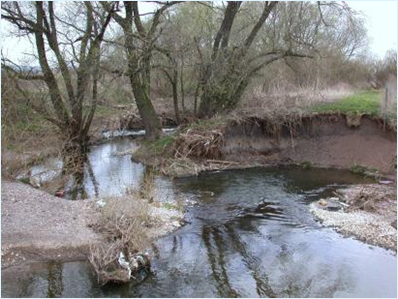Initiate natural channel dynamics to promote natural regeneration
Contents
Initiate natural channel dynamics to promote natural regeneration
General description
Naturally, river flow causes erosion and deposition of the river banks and bed. These natural channel dynamics result in a specific channel planform and channel features like steep cutbanks, bars, and pools, which can only persist in the long-term if they are rejuvenated during high flow events (otherwise e.g. pools fill with fine sediment, cutbanks flatten). In degraded rivers, channel dynamics are limited by bed and bank fixation, hydrological alterations like the reduction of morphogenic flows due to damming or water abstraction, changes in sediment transport (e.g. sediment deficit downstream of dams), and the lack of natural flow obstructions like large wood and boulders.
Instead of actively building a more natural channel planform and channel features using heavy machinery, natural channel dynamics can be initiated to “let the river do the work” (passive restoration). This is usually done by simply abandoning maintenance as well as removing bed and bank fixation and placing natural flow obstructions in the river to accelerate the morphological changes (e.g. large wood or boulders re-directing the flow towards the river banks or bed and causing bank and bed erosion).
Restoring a meandering planform by initiating lateral channel dynamics is described in more detail in the fact-sheet on re-meandering: Allow/increase lateral channel migration or river mobility
Applicability
Natural channel dynamics can be initiated if the respective changes in channel-bed level and bank erosion do not compromise flood protection or damage infrastructure works on the floodplain. Therefore, it can especially be applied in rural areas and applicability is limited in urban areas. Natural channel dynamics are limited in low gradient rivers with highly cohesive bank material (e.g. lowland rivers in loamy alluvial plains), and significant changes in channel morphology can only be expected in the long-term. Alternatively, the cohesive bank material can be excavated. However, this increases the risk of initiating non-natural channel dynamics and planform. Besides a low channel slope and cohesive bank material, natural channel dynamics might be limited due to hydrological changes or a sediment deficit. Therefore, it is crucial to ensure natural sediment transport and that morphogenic flows occur which cause natural erosional and depositional processes.
Expected effect of measure on (including literature citations):
There are only few studies that explicitly investigated the effect of passive restoration (initiating natural channel dynamics). The results reported in Jähnig et al. (2013) indicate that passive restoration can have similar positive effects on habitat diversity compared to active restoration.
References
Pressures that can be addressed by this measure
- Channelisation / cross section alteration
- Alteration of riparian vegetation
- Alteration of instream habitat
Case studies where this measure has been applied
- Renaturierung Untere Havel
- Lahn Cölbe
- Freienbrink
- Vääräjoki - Niskakoski
- Regelsbrunner Aue
- Kuivajoki - Hirvaskoski
- Carrión
- Thur
- Narew river restoration project
- Uilenkamp - Meander reconnection
- Töss
- Blenheim Palace Project
- River Brent at Tokyngton Park
- Stream valleys in the Arnsberger forest (LIFE project)
- Enns - Aich
- Amesbury - Demonstrating strategic restoration and management STREAM (LIFE05 NAT/UK/000143)
- Chilhampton - Demonstrating strategic restoration and management STREAM (LIFE05 NAT/UK/000143)
- Fovant - Demonstrating strategic restoration and management STREAM (LIFE05 NAT/UK/000143)
- Upper Woodford - Demonstrating strategic restoration and management STREAM (LIFE05 NAT/UK/000143)
- Woodgreen - Demonstrating strategic restoration and management STREAM (LIFE05 NAT/UK/000143)
- Niederwerrieser Weg - Optimisation of the pSCI “Lippe floodplain between Hamm and Hangfort” (LIFE05/NAT/D/000057)
- Oberwerries - Optimisation of the pSCI “Lippe floodplain between Hamm and Hangfort” (LIFE05/NAT/D/000057)
- Ahlen-Dolberg - Optimisation of the pSCI “Lippe floodplain between Hamm and Hangfort” (LIFE05/NAT/D/000057)
- Soest - Optimisation of the pSCI “Lippe floodplain between Hamm and Hangfort” (LIFE05/NAT/D/000057)
- Conservation of Atlantic Salmon in Scotland (LIFE 04/NAT/GB/000250)
- Northern Sweden - From source to sea, restoring river Moälven (LIFE05 NAT/S/000109)
- Becva
- River Cole EU-LIFE
- Rhine - Meinerswijk
- Hampshire Avon - Hale
- Hampshire Avon - Seven Hatches
- Drava - River Widening Amlach/St. Peter
- Drava - River Widening Rosenheim
- Donau - Rührsdorf-Rossatz (LIFE03 NAT/A/000009)
- Rhine - Emmericher Ward (LIFE10 NAT/DE/000010)
- Lower Traun
- Lippeaue Klostermersch
- Ruhr Binnerfeld
